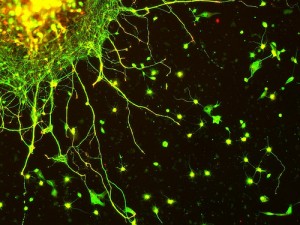
A few weeks ago, the Human Brain Project announced that it had been selected as a finalist in a competition whose winners will get €1 billion worth of funding from the EU. The Human Brain Project (HBP) plans to use the prize money to build a simulation of the human brain on a supercomputer.
HBP is a consortium of heavy hitters, combining neuroscience expertise with supercomputing know-how. The project’s leader, Henry Markram, has been working towards this goal for years with HBP’s predecessor, the Blue Brain project. Markram is a big deal; in the mid-1990s, he identified a crucial property of the brain’s function called spike timing dependent plasticity, a property of neurons that explains, for example, how they wire together to form memories. In 2005, he partnered with IBM to build a detailed model of the neocortex–the part of the brain that’s involved in perception and conscious thought–on what was at the time the world’s fourth-fastest supercomputer, the Blue Gene L (which explains the Blue Brain moniker).
A full-scale brain simulation would help us obtain insights into neurological disorders and perhaps even untangle the neurobiological underpinnings of intelligence and personality. No Blue Brain story was complete without hints that the Blue Brain simulation might become conscious: When I interviewed Markram in 2008, he told me that he envisioned a Pinocchio-like entity that would autonomously surf the internet to develop and augment its understanding of itself and its universe.
Big plans! But, over the past couple of years, no one seems to done much investigation into Blue Brain’s actual progress, instead repeating that we might be on the brink of building a conscious machine. As far as I can tell, the Blue Brain/Human Brain Project team is still working with a single simulated neocortical column, a 2 millimeter-diameter hunk of brain matter that contains 10,000 of the brain’s roughly 100 billion neurons. I suspect that further research will get underway when the EU funding happens, and now that they’ve gotten a supercomputer upgrade from IBM.
And when that happens, it’s important for us tech journalists to bring our A-game. Because to quote everyone’s favourite AI, “All this has happened before, and all this will happen again.” If the coverage of the Blue Brain project in the past few years is any indication, journalists covering the Human Brain Project will fall down some familiar rabbit holes. Continue reading






